Jun Xue
A Causality-Inspired Model for Intima-Media Thickening Assessment in Ultrasound Videos
Mar 16, 2025Abstract:Carotid atherosclerosis represents a significant health risk, with its early diagnosis primarily dependent on ultrasound-based assessments of carotid intima-media thickening. However, during carotid ultrasound screening, significant view variations cause style shifts, impairing content cues related to thickening, such as lumen anatomy, which introduces spurious correlations that hinder assessment. Therefore, we propose a novel causal-inspired method for assessing carotid intima-media thickening in frame-wise ultrasound videos, which focuses on two aspects: eliminating spurious correlations caused by style and enhancing causal content correlations. Specifically, we introduce a novel Spurious Correlation Elimination (SCE) module to remove non-causal style effects by enforcing prediction invariance with style perturbations. Simultaneously, we propose a Causal Equivalence Consolidation (CEC) module to strengthen causal content correlation through adversarial optimization during content randomization. Simultaneously, we design a Causal Transition Augmentation (CTA) module to ensure smooth causal flow by integrating an auxiliary pathway with text prompts and connecting it through contrastive learning. The experimental results on our in-house carotid ultrasound video dataset achieved an accuracy of 86.93\%, demonstrating the superior performance of the proposed method. Code is available at \href{https://github.com/xielaobanyy/causal-imt}{https://github.com/xielaobanyy/causal-imt}.
Region-Based Optimization in Continual Learning for Audio Deepfake Detection
Dec 16, 2024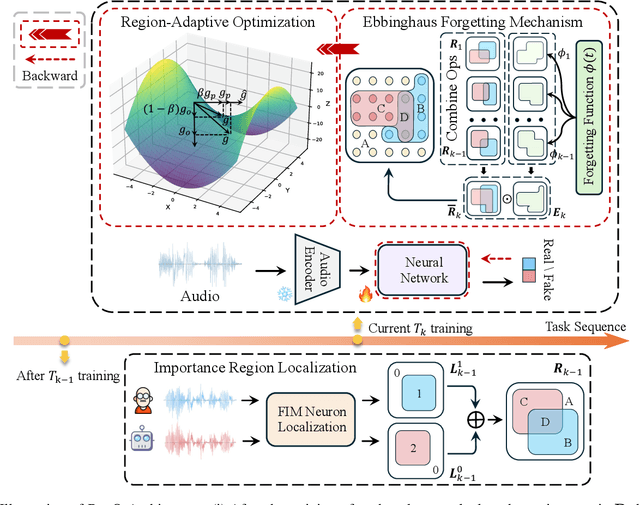
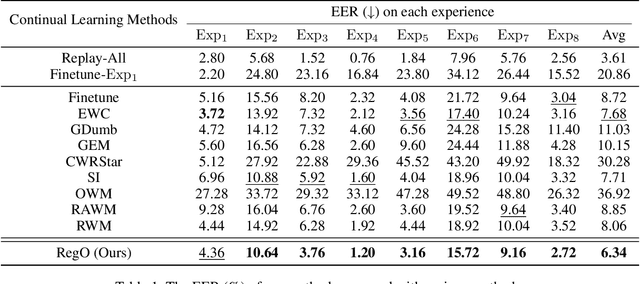

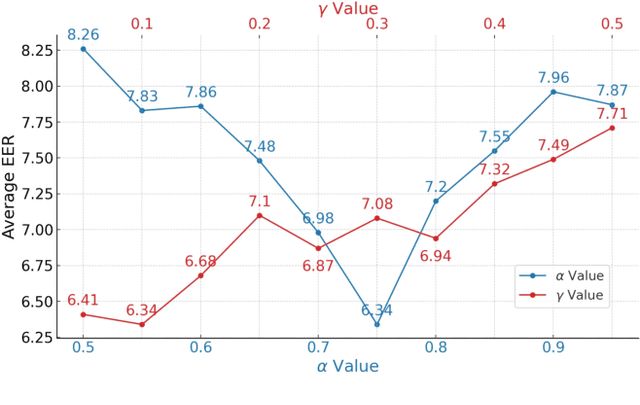
Abstract:Rapid advancements in speech synthesis and voice conversion bring convenience but also new security risks, creating an urgent need for effective audio deepfake detection. Although current models perform well, their effectiveness diminishes when confronted with the diverse and evolving nature of real-world deepfakes. To address this issue, we propose a continual learning method named Region-Based Optimization (RegO) for audio deepfake detection. Specifically, we use the Fisher information matrix to measure important neuron regions for real and fake audio detection, dividing them into four regions. First, we directly fine-tune the less important regions to quickly adapt to new tasks. Next, we apply gradient optimization in parallel for regions important only to real audio detection, and in orthogonal directions for regions important only to fake audio detection. For regions that are important to both, we use sample proportion-based adaptive gradient optimization. This region-adaptive optimization ensures an appropriate trade-off between memory stability and learning plasticity. Additionally, to address the increase of redundant neurons from old tasks, we further introduce the Ebbinghaus forgetting mechanism to release them, thereby promoting the capability of the model to learn more generalized discriminative features. Experimental results show our method achieves a 21.3% improvement in EER over the state-of-the-art continual learning approach RWM for audio deepfake detection. Moreover, the effectiveness of RegO extends beyond the audio deepfake detection domain, showing potential significance in other tasks, such as image recognition. The code is available at https://github.com/cyjie429/RegO
Generalized Multimodal Fusion via Poisson-Nernst-Planck Equation
Oct 20, 2024



Abstract:Previous studies have highlighted significant advancements in multimodal fusion. Nevertheless, such methods often encounter challenges regarding the efficacy of feature extraction, data integrity, consistency of feature dimensions, and adaptability across various downstream tasks. This paper proposes a generalized multimodal fusion method (GMF) via the Poisson-Nernst-Planck (PNP) equation, which adeptly addresses the aforementioned issues. Theoretically, the optimization objective for traditional multimodal tasks is formulated and redefined by integrating information entropy and the flow of gradient backward step. Leveraging these theoretical insights, the PNP equation is applied to feature fusion, rethinking multimodal features through the framework of charged particles in physics and controlling their movement through dissociation, concentration, and reconstruction. Building on these theoretical foundations, GMF disassociated features which extracted by the unimodal feature extractor into modality-specific and modality-invariant subspaces, thereby reducing mutual information and subsequently lowering the entropy of downstream tasks. The identifiability of the feature's origin enables our approach to function independently as a frontend, seamlessly integrated with a simple concatenation backend, or serve as a prerequisite for other modules. Experimental results on multiple downstream tasks show that the proposed GMF achieves performance close to the state-of-the-art (SOTA) accuracy while utilizing fewer parameters and computational resources. Furthermore, by integrating GMF with advanced fusion methods, we surpass the SOTA results.
MpoxMamba: A Grouped Mamba-based Lightweight Hybrid Network for Mpox Detection
Sep 06, 2024



Abstract:Due to the lack of effective mpox detection tools, the mpox virus continues to spread worldwide and has once again been declared a public health emergency of international concern by the World Health Organization. Deep learning-based mpox detection tools are crucial to alleviate mpox outbreak. However, existing methods have difficulty in achieving a good trade-off between detection performance, parameter size, and model complexity, which is crucial for practical applications and widespread deployment, especially in resource-limited scenarios. Given that the success of Mamba in modeling long-range dependencies and its linear complexity, we proposed a lightweight hybrid architecture called MpoxMamba. MpoxMamba utilizes deep separable convolutions to extract local feature representations in mpox skin lesions, and greatly enhances the model's ability to model the global contextual information by grouped Mamba modules. Experimental results on two widely recognized mpox datasets demonstrate that MpoxMamba outperforms existing mpox detection methods and state-of-the-art lightweight models. We also developed a web-based online application to provide free mpox detection services to the public in the epidemic areas (http://5227i971s5.goho.co:30290). The source codes of MpoxMamba are available at https://github.com/YubiaoYue/MpoxMamba.
Frequency-mix Knowledge Distillation for Fake Speech Detection
Jun 14, 2024Abstract:In the telephony scenarios, the fake speech detection (FSD) task to combat speech spoofing attacks is challenging. Data augmentation (DA) methods are considered effective means to address the FSD task in telephony scenarios, typically divided into time domain and frequency domain stages. While each has its advantages, both can result in information loss. To tackle this issue, we propose a novel DA method, Frequency-mix (Freqmix), and introduce the Freqmix knowledge distillation (FKD) to enhance model information extraction and generalization abilities. Specifically, we use Freqmix-enhanced data as input for the teacher model, while the student model's input undergoes time-domain DA method. We use a multi-level feature distillation approach to restore information and improve the model's generalization capabilities. Our approach achieves state-of-the-art results on ASVspoof 2021 LA dataset, showing a 31\% improvement over baseline and performs competitively on ASVspoof 2021 DF dataset.
RawBMamba: End-to-End Bidirectional State Space Model for Audio Deepfake Detection
Jun 10, 2024Abstract:Fake artefacts for discriminating between bonafide and fake audio can exist in both short- and long-range segments. Therefore, combining local and global feature information can effectively discriminate between bonafide and fake audio. This paper proposes an end-to-end bidirectional state space model, named RawBMamba, to capture both short- and long-range discriminative information for audio deepfake detection. Specifically, we use sinc Layer and multiple convolutional layers to capture short-range features, and then design a bidirectional Mamba to address Mamba's unidirectional modelling problem and further capture long-range feature information. Moreover, we develop a bidirectional fusion module to integrate embeddings, enhancing audio context representation and combining short- and long-range information. The results show that our proposed RawBMamba achieves a 34.1\% improvement over Rawformer on ASVspoof2021 LA dataset, and demonstrates competitive performance on other datasets.
Progressive Distillation Based on Masked Generation Feature Method for Knowledge Graph Completion
Jan 19, 2024Abstract:In recent years, knowledge graph completion (KGC) models based on pre-trained language model (PLM) have shown promising results. However, the large number of parameters and high computational cost of PLM models pose challenges for their application in downstream tasks. This paper proposes a progressive distillation method based on masked generation features for KGC task, aiming to significantly reduce the complexity of pre-trained models. Specifically, we perform pre-distillation on PLM to obtain high-quality teacher models, and compress the PLM network to obtain multi-grade student models. However, traditional feature distillation suffers from the limitation of having a single representation of information in teacher models. To solve this problem, we propose masked generation of teacher-student features, which contain richer representation information. Furthermore, there is a significant gap in representation ability between teacher and student. Therefore, we design a progressive distillation method to distill student models at each grade level, enabling efficient knowledge transfer from teachers to students. The experimental results demonstrate that the model in the pre-distillation stage surpasses the existing state-of-the-art methods. Furthermore, in the progressive distillation stage, the model significantly reduces the model parameters while maintaining a certain level of performance. Specifically, the model parameters of the lower-grade student model are reduced by 56.7\% compared to the baseline.
DGSD: Dynamical Graph Self-Distillation for EEG-Based Auditory Spatial Attention Detection
Sep 07, 2023

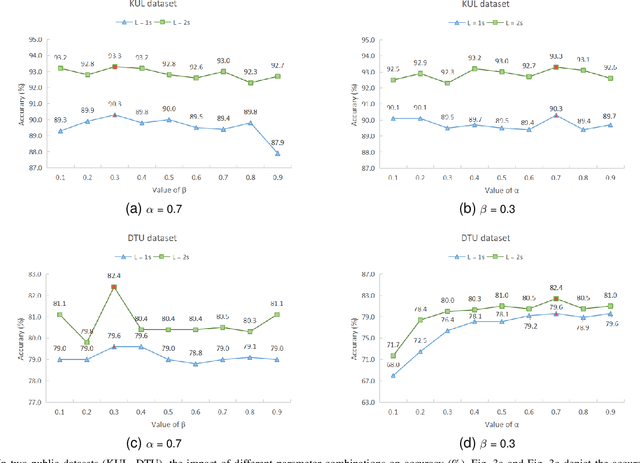

Abstract:Auditory Attention Detection (AAD) aims to detect target speaker from brain signals in a multi-speaker environment. Although EEG-based AAD methods have shown promising results in recent years, current approaches primarily rely on traditional convolutional neural network designed for processing Euclidean data like images. This makes it challenging to handle EEG signals, which possess non-Euclidean characteristics. In order to address this problem, this paper proposes a dynamical graph self-distillation (DGSD) approach for AAD, which does not require speech stimuli as input. Specifically, to effectively represent the non-Euclidean properties of EEG signals, dynamical graph convolutional networks are applied to represent the graph structure of EEG signals, which can also extract crucial features related to auditory spatial attention in EEG signals. In addition, to further improve AAD detection performance, self-distillation, consisting of feature distillation and hierarchical distillation strategies at each layer, is integrated. These strategies leverage features and classification results from the deepest network layers to guide the learning of shallow layers. Our experiments are conducted on two publicly available datasets, KUL and DTU. Under a 1-second time window, we achieve results of 90.0\% and 79.6\% accuracy on KUL and DTU, respectively. We compare our DGSD method with competitive baselines, and the experimental results indicate that the detection performance of our proposed DGSD method is not only superior to the best reproducible baseline but also significantly reduces the number of trainable parameters by approximately 100 times.
U-SEANNet: A Simple, Efficient and Applied U-Shaped Network for Diagnosis of Nasal Diseases on Nasal Endoscopic Images
Sep 02, 2023Abstract:Numerous studies have affirmed that deep learning models can facilitate early diagnosis of lesions in endoscopic images. However, the lack of available datasets stymies advancements in research on nasal endoscopy, and existing models fail to strike a good trade-off between model diagnosis performance, model complexity and parameters size, rendering them unsuitable for real-world application. To bridge these gaps, we created the first large-scale nasal endoscopy dataset, named 7-NasalEID, comprising 11,352 images that contain six common nasal diseases and normal samples. Subsequently, we proposed U-SEANNet, an innovative U-shaped architecture, underpinned by depth-wise separable convolution. Moreover, to enhance its capacity for detecting nuanced discrepancies in input images, U-SEANNet employs the Global-Local Channel Feature Fusion module, enabling it to utilize salient channel features from both global and local contexts. To demonstrate U-SEANNet's potential, we benchmarked U-SEANNet against seventeen modern architectures through five-fold cross-validation. The experimental results show that U-SEANNet achieves a commendable accuracy of 93.58%. Notably, U-SEANNet's parameters size and GFLOPs are only 0.78M and 0.21, respectively. Our findings suggest U-SEANNet is the state-of-the-art model for nasal diseases diagnosis in endoscopic images.
US-SFNet: A Spatial-Frequency Domain-based Multi-branch Network for Cervical Lymph Node Lesions Diagnoses in Ultrasound Images
Aug 31, 2023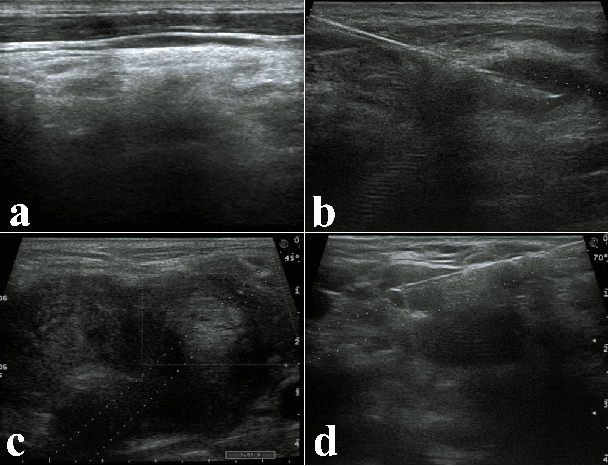
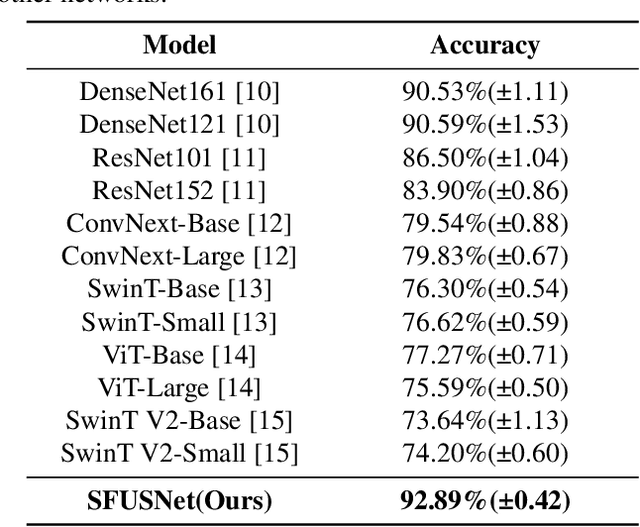
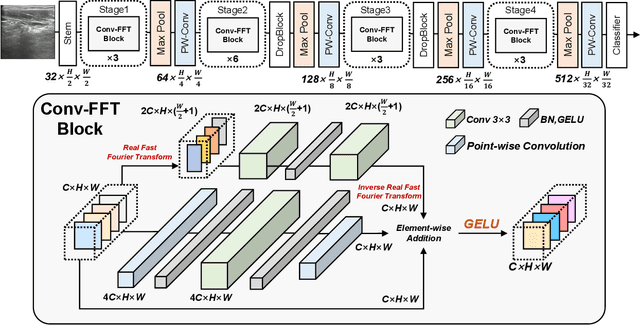
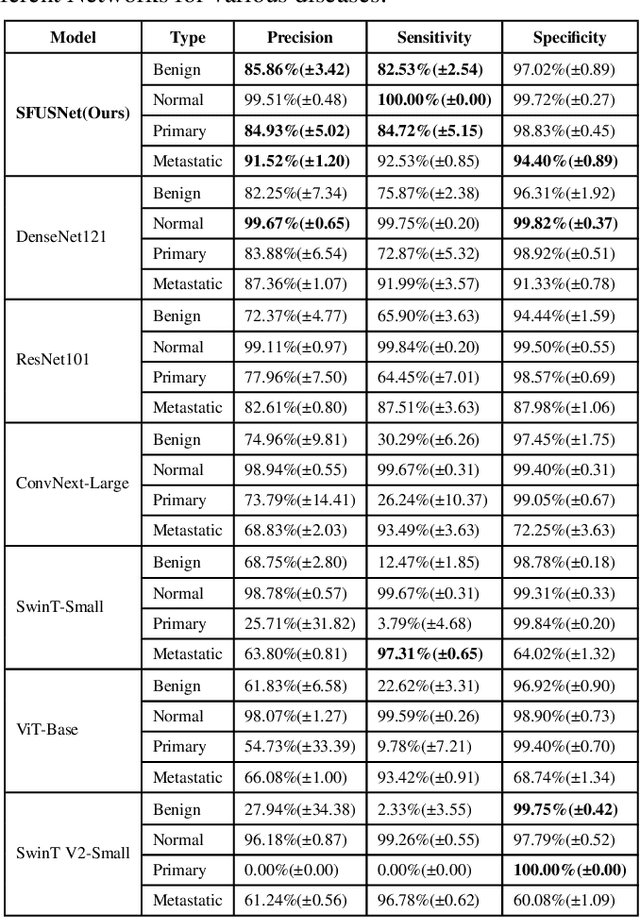
Abstract:Ultrasound imaging serves as a pivotal tool for diagnosing cervical lymph node lesions. However, the diagnoses of these images largely hinge on the expertise of medical practitioners, rendering the process susceptible to misdiagnoses. Although rapidly developing deep learning has substantially improved the diagnoses of diverse ultrasound images, there remains a conspicuous research gap concerning cervical lymph nodes. The objective of our work is to accurately diagnose cervical lymph node lesions by leveraging a deep learning model. To this end, we first collected 3392 images containing normal lymph nodes, benign lymph node lesions, malignant primary lymph node lesions, and malignant metastatic lymph node lesions. Given that ultrasound images are generated by the reflection and scattering of sound waves across varied bodily tissues, we proposed the Conv-FFT Block. It integrates convolutional operations with the fast Fourier transform to more astutely model the images. Building upon this foundation, we designed a novel architecture, named US-SFNet. This architecture not only discerns variances in ultrasound images from the spatial domain but also adeptly captures microstructural alterations across various lesions in the frequency domain. To ascertain the potential of US-SFNet, we benchmarked it against 12 popular architectures through five-fold cross-validation. The results show that US-SFNet is SOTA and can achieve 92.89% accuracy, 90.46% precision, 89.95% sensitivity and 97.49% specificity, respectively.
 Add to Chrome
Add to Chrome Add to Firefox
Add to Firefox Add to Edge
Add to Edge